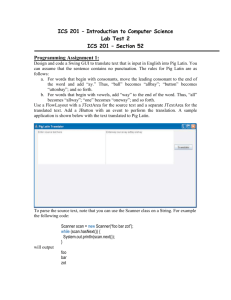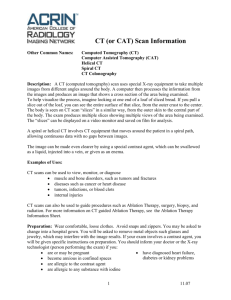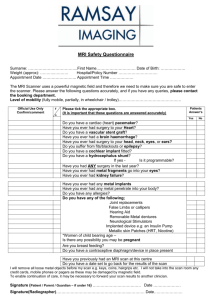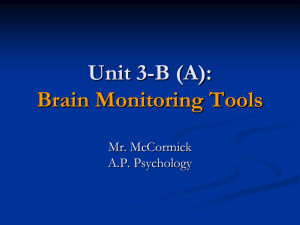Digit Ratio Measurement Guide
advertisement
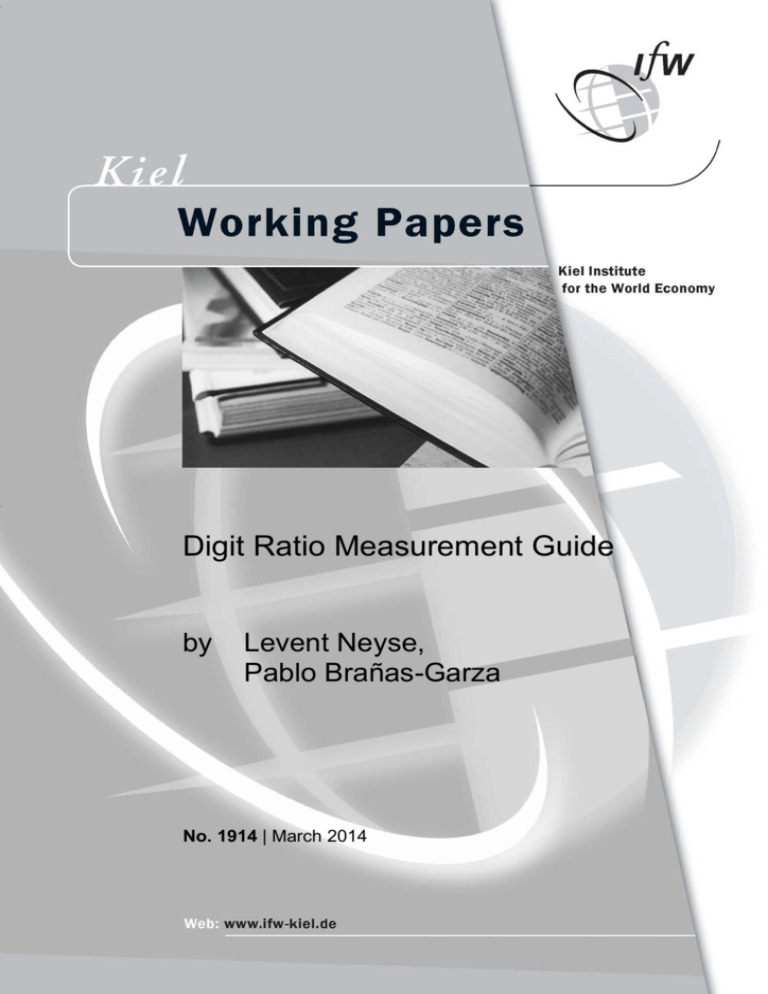
Digit Ratio Measurement Guide by Levent Neyse, Pablo Brañas-Garza No. 1914 | March 2014 Digit Ratio Measurement Guide Levent Neyse Pablo Brañas-Garza Institute for the World Economy (IfW) levent.neyse@ifw-kiel.de Middlesex University London branasgarza@gmail.com Abstract Literature on Digit Ratio is rapidly growing in Economics. Quite surprisingly we observe that there is no consensus about how to make an accurate measurement in such a delicate task. Along this brief document we offer some concise guidance of how to scan the hands using digital scanners and provide a comprehensive guideline to make a reliable measurement of the 2D:4D. Furthermore, we point out the most common imaging and measurement errors. We also provide a number of hints aimed to avoid these errors that in some cases may cause systematic inaccuracies. Keywords: 2D:4D; Digit Ratio; Measurement; Guide Introduction This paper is motivated by the lack of agreement about how we measure digit ratio and also which hands to measure. 2d:4d studies in Economics have used various methods so far. Brañas-Garza and Rustichini (2011) use photocopies of the right hands, Garbarino et al. (2011) use scans and they measure the mean of both hands. Turiegano & Sanchez-Pagés (2010)1 and Pearson & Schipper (2012) use the scans of the right hand only. Recent papers have also shown that both hands –and not only the right one- are providing valuable information about economic behavior (see BrañasGarza et al. 2013 and 2014). In fact, endocrinology studies claim that the left hand is a more precise proxy of fetal exp -Cruz et al. 2012). Since the measure depends on small units of length and is unobservable without using a measurement tool, self-reported measurements have been argued to be invalid (Brañas-Garza and Kovárík, 2013). The other options, like direct measurement or 1 They use TPS Software Package to measure the scans. (http://life.bio.sunysb.edu/morph/) 1 photocopies, are also short of accuracy. Flatbed scanners appear to be the most appropriate tools in terms of precision, practicality and costs.2 In the following we present a simple but thorough guide to measure both hands using digital scans. We comment on the most common errors and we also provide a number of hints aimed to avoid these issues. Which Imaging Device? Although there are various options (like direct measurement, photocopies or X-Ray) digital scans are extremely useful in the measurement process. With image editing softwares (i.e. Adobe Photoshop®) you can adjust the contrast of the images, crop, sharpen, zoom in-out and work on it even pixel by pixel. Do you really need these? Yes. At least for the 15% of your sample you need them. Because even if it seems like everything went well in the scanning process, when you start to measure the ratios, you realize slight differences between the images. These differences do not seem to be large at the fi t ight nd y m y think th t th y “j t t nd d ”. B t you should not forget that we are dealing not with centimeters but millimeters. Therefore, even the slightest measurement deviation may end up being a falsely measured digit ratio distribution in the overall dataset. L t’ f n th t 15% f th mpl . Wh t are those differences between images? First of all, every individual has a unique body structure; therefore unique hand shapes. Some have visible lines, some do not and also some lines are difficult to interpret (See Figure 1). With the software you can adjust the darkness and the contrast of the image so that the lines may get clearer. “C v ” t l in Ph t h p® is highly useful on this issue.3 Even if you make very clear instructions and check each image while scanning; there always are scans where you cannot see the details. The participants sometimes push on the scanner too hard, or show their fingertips (See Figure 2) instead of their fingers (so they create a gap between hand and the scanner). Participants also sometimes 2 Although we do not want to name any specific scanner brands, we obtained the best results by far with Epson Perfection 1660. 3 Ctrl+M in PC and Cmd+M in Mac are the keyboard shortcuts 2 move their hands or fingers during the scan; so you find blurred images in the data folder (See Figure 3). Beside the other mentioned devices above, X-Rays are used to scan the hands of the subjects (Manning et al., 2000; McIntyre, 2005). However, it is not common to have an X-Ray machine in a non-medicine faculty or in the field. Furthermore, Institutional Review Boards (IRB) are relatively hesitant about approving X-Rays due to radiation exposure. Although the impact of radiation is reducible and it is way less harmful than the other imaging techniques (i.e. tomography), ethical concern due to a slightly rising cancer risk in excessive radiation exposure (See Gonzales & Darby 2004) is a substantial reason behind the rigor of IRBs.4 Figure 1: A difficult measurement: The lines are not clear. Photocopies, on the other hand, are always tricky. The quality is usually low and even with a digital caliper it is not that easy to make an excellent measurement. But if you do not have an option in the field for instance or you happen to find photocopies on your desk with such a note from a colleague “Wh t nw d b t th ?” you must find a solution. That solution is to scan all of the photocopies and do whatever you do with the scanning method. 4 See the report of U.S. Food and Drug Administration report for further details: http://www.fda.gov/downloads/ForConsumers/ConsumerUpdates/UCM185316.pdf 3 Direct measurement with a digital caliper does not give you the option to re-measure and it is more difficult to make an accurate measurement if the hand is not on a 2D surface as in the images. Figure 2: An incorrect scan: Lines are not visible. Scanning Hands in Practice Check the hands first Now we will present some information about how to proceed. At the end of the d m nt y will find “ h k li t”. Make sure that the participant does not wear any jewelry like a shiny ring. It may reflect the light in the scanner and ruin the scan. In some cases the ring may leave a mark on the skin. You can wait a bit and ask the participant to rub her/his hand a bit after taking off the ring. Some participants (mostly students) forget to clean some “notes” they wrote on their hands. It is better to keep a pack of wet tissue by the scanner just in case. 4 Some participants may have a hand injury or a broken finger. Ask them if they had any injuries in the past. Exclude them from the dataset if they had. Figure 3: An incorrect scan: Finger tips are not visible Give Brief Information We usually explain to the subjects what we n d: “We are trying to measure your finger lengths. We are not taking your fingerprints. So, please do not push the scanner with your fingertips. Just place both your hands firmly on the scanner; making sure that the scanner can capture a clear image of your hand. And please do not move your hand until we y .”5 ID Number We should be extremely cautious with anonymity when measuring digit ratio. Since you cannot work with the names in the dataset, you can give a number to each subject and stick this id number with a paper (i.e. Post-it) in the palm (see the example provided in Figure 4). 5 Occasionally we hear complaints concerning the finger marks. You can provide small stickers to those, who are concerned about giving their fingerprints. So that they can use them to cover their finger prints. Recall that those should not cover the finger tips and the lines. 5 Recall that this paper must not cover the bottom creases of fingers. With id numbers as such M1234, F1235 you can record the gender of the participant. It is also a quite good idea to save the file using the same id number. Recall that putting the letter F or M in the beginning of the number is more practical than putting it in the end. You can sort the data easier in the dataset. Scan! Place the both hands of the subjects on the scanner, making sure that all the fingers are straight and visible. The hands do not have to be at the same angle so you can place the hands as you like in order to place all the fingers on the flatbed properly. Depending on your scanner you may want to cover the hands with a fabric cover or a t-shirt. You do not have to close the cover of the scanner. But you will find your own way depending on your scanner anyway. Please see previous Figure 2 and 3 to avoid errors. Now you can press the scan button and wait. The participants usually ask, “Wh t i thi b t?” in those 10 seconds. And you say, “Th l ti n b tw n xp im nt l lt nd fing t di l ngth ”. Thi gg ting m xpl n ti n i usually enough. Check Together Check the image right after the scan together with the participant. So, if there is anything wrong with the scan, you can explain the problem and re-scan. In the case that you get a scan like shown in Figure 3 you may need to run the whole procedure once again. If nothing is wrong you must have a nice picture like shown in Figure 4 or Figure 5. Save the image in two different folders in the computer just in case. .jpg, .jpeg or .pdf are the most common file extensions that we use. Since you are going to need to connect experimental results with the scans you can use a unique id number in the experiment and in the scans. It is better to rename the image right after the scan with this id number. Participant can go now. A sample of a clean scan can be seen in Figure 4 and Figure 5. 6 Figure 4: Correct Scan Figure 5: Correct Scan 7 We usually clean the scanner glass after each scan with a towel or a fabric in order to provide subjects a relatively hygienic scan. Measurement Digital measurements In Photoshop© th n t, y i “ l t l” n m lly n th l ft h nd id n ight li k th “ y d pp t l” nd h switch on the toolbox f m th “wind w” m n th b v th l t f th l th n. If .Y n n if it is not on. You can change the rotation of the image here: Image>Image Rotation Zoom in the picture as much as you like. You can change the measurement units (cmmm-pix l t ) in “p f n ”. Make sure that you use a unique unit for the whole sample. If you start with the pixels do not switch it back to cm again in that sample. Since you are dealing not with absolute values but with ratios, you can use any unit in the end. A m nti n d b v “ v ”t l i quite handy when it is difficult to interpret the lines in the hand or the scan quality is not good enough. L t’ g t started with the measurement. Figure 6 provides some additional help to do the measurement: For the ring finger take the first line in the basal crease. Click on the median of the line, right in the middle. Then click on the fingertip carefully. Sometimes the shadow of the finger or the fingernail can be misleading. What Photoshop© does is to measure the distance between two reference points. On the top of the screen; below the menu buttons you see many numbers measuring many things. The number we see next to L1 is the number we are looking for. For the index finger, follow the same procedure. But this time the line is a bit less clear in the basal crease. Try to find the best point in order to draw a straight line up until the fingertip. Now save these numbers. Dividing the length of index finger to the length of ring finger will give you the ratio. (See Figure 6) 8 Figure 6: Digit Ratio Measurement Measure Once Again After finishing the whole sample, do not touch the measurements for a day or so. Then re-measure everything. It is a common procedure. If the measurements are correct you will find at least 90-95% correlation between the sets of two ratios. You can use the mean of these two ratios in the dataset as well. Some Important Points 1- Digit Ratio is an ethnicity-related value. So focus on only one race. If your sample is mostly Caucasians for example, you should exclude the nonCaucasians in the dataset. You should have this information from the participants. You can simply add the list in to the questionnaire (which you probably run anyway), so that the participants can choose themselves. There 9 are differences across count i ’ inf m ti n g th ing t hniq . O research provided us various racial subgroups. For convenience we abstracted the list as: Caucasian, African, Mid-A i n Indi , P ki t n…), E t-Asian Chin , K , J p n…) nd Mix d. Th th bg p h Carribean, Eskimo et cetera. So, you may want to define your own list depending on your sample. 2- Scan both hands. Although there are many papers reporting only right hands now you need to report the results for both hands in many journals. Scan both, just in case. As noted before, papers have also shown that both hands –and not only the right one- are providing valuable information about economic behavior (see Brañas-Garza et al. 2013 and 2014). 3- Some of the files are saved too large. Especially when they are in PNG format. Recall that when you import these files not one by one but 10 by 10 in Photoshop© for instance. If an image is, say 75MBs, the measurement will take more time. A high-resolution scanner is a must but you do not need to excess 300dpi and a width of 2400 pixels. Box 1: Check List 1- No rings, clean hands, no ring marks on the skin. 2- Ask if the subject has had any hand injuries before. Like a broken finger etc. 3- Scan the hand with the id number so that it will be easier to integrate it in the dataset. 4- Add gender information to the id number. 5- Save the information about race. 6- Place the hands on scanner firmly. 7- Cover the hands with a fabric or a black t-shirt if necessary. 8- Check the image together with the participant; if necessary scan again. 9- Save the files twice 10 References Bosch-Domènech, A., Brañas-Garza, P., & Espín, AM. 2014. Can exposure to prenatal sex hormones (2D:4D) predict cognitive reflection Psycho- neuroendocrinology, forthcoming. Brañas- z , P., K vář k, J., & N y , L. 2013. S nd-to-fourth digit ratio has a non-monotonic impact on altruism. PLoS ONE 8(4), e60419. Brañas- z , P., & K vář k, J. 2013. Digit Ratios and Social Preferences. A comment on Buser, unpublished. Brañas-Garza, P., & Rustichini A. 2011. Organizing Effects of Testosterone and Economic Behavior: Not Just Risk Taking. PLoS ONE 6(12): e29842. de González, A. B., & Darby, S. (2004). Risk of cancer from diagnostic X-rays: estimates for the UK and 14 other countries. The Lancet 363(9406), 345-351. Garbarino, E., Slonim, R., & Sydnor, J. 2011. Digit Ratios (2d:4d) as Predictors of Risky Decision Making for Both Sexes. Journal of Risk and Uncertainty 42(1): 1-26. 0.1007/s11166-010-9109-6. -Cruz E, Huguet J, Piqueras M. 2012. Second to fourth digit ratio, adult testosterone level and testosterone deficiency. British Journal of Urology International 109(2): 266- 71. Manning, J. T., Trivers, R. L., Thornhill, R., & Singh, D. (2000). The 2nd: 4th digit ratio and asymmetry of hand performance in Jamaican children. Laterality 5(2), 121132. McIntyre, M. H., Ellison, P. T., Lieberman, D. E., Demerath, E., & Towne, B. (2005). The development of sex differences in digital formula from infancy in the Fels Longitudinal Study. Proceedings of the Royal Society B: Biological Sciences 272(1571), 1473-1479. Pearson, M., & Schipper, B. 2012. The Visible Hand: Finger Ratio (2D:4D) and Competitive Bidding. Experimental Economics 15, 510-529. Sanchez-Pagés, S., & Turiegano, E. 2010. Testosterone, Facial Symmetry and Cooperation in the Prisoners' Dilemma. Physiology & Behavior 99(3): 355-361. 10.1016/j.physbeh.2009.11.013. 11
